The Impact of Armed Conflict on Women and Girls - UNFPA
The Impact of Armed Conflict on Women and Girls - UNFPA
The Impact of Armed Conflict on Women and Girls - UNFPA
You also want an ePaper? Increase the reach of your titles
YUMPU automatically turns print PDFs into web optimized ePapers that Google loves.
BACKGROUND<br />
<strong>Women</strong> <strong>and</strong> girls c<strong>on</strong>stitute close to 80 per cent <str<strong>on</strong>g>of</str<strong>on</strong>g> internally displaced<br />
people <strong>and</strong> refugees worldwide. Although war has always victimized n<strong>on</strong>combatants,<br />
c<strong>on</strong>temporary armed c<strong>on</strong>flict exploits, maims <strong>and</strong> kills civilians more<br />
callously <strong>and</strong> systematically than ever before. This aspect <str<strong>on</strong>g>of</str<strong>on</strong>g> armed c<strong>on</strong>flict<br />
raises serious ethical, analytical <strong>and</strong> operati<strong>on</strong>al challenges for the United<br />
Nati<strong>on</strong>s system as a whole, including <strong>UNFPA</strong>. Not <strong>on</strong>ly does a m<strong>and</strong>ate exist to<br />
address the pressing issues <str<strong>on</strong>g>of</str<strong>on</strong>g> the impact <str<strong>on</strong>g>of</str<strong>on</strong>g> c<strong>on</strong>flict <strong>on</strong> women <strong>and</strong> girls but a<br />
moral obligati<strong>on</strong> exists as well.<br />
Effects <str<strong>on</strong>g>of</str<strong>on</strong>g> war <strong>on</strong> women <strong>and</strong> girls<br />
Modern warfare has had a devastating effect <strong>on</strong> the lives <strong>and</strong> dignity <str<strong>on</strong>g>of</str<strong>on</strong>g><br />
women <strong>and</strong> girls, as well as <strong>on</strong> the health <strong>and</strong> educati<strong>on</strong>al services that are<br />
essential to family <strong>and</strong> community survival. Al<strong>on</strong>g with reproductive health<br />
complicati<strong>on</strong>s, the adverse effects <str<strong>on</strong>g>of</str<strong>on</strong>g> c<strong>on</strong>flict hit women <strong>and</strong> girls harder than it<br />
does their male counterparts, since deliberate gender-based violence <strong>and</strong><br />
discriminati<strong>on</strong> are rampant in these settings. As such, these gender-specific<br />
threats to women <strong>and</strong> girls compound the challenges <str<strong>on</strong>g>of</str<strong>on</strong>g> ensuring their protecti<strong>on</strong>.<br />
This has resulted in gaps in the design <strong>and</strong> delivery <str<strong>on</strong>g>of</str<strong>on</strong>g> assistance <strong>and</strong> protecti<strong>on</strong>,<br />
short-changing the priority populati<strong>on</strong> <str<strong>on</strong>g>of</str<strong>on</strong>g> women in c<strong>on</strong>flict <strong>and</strong> post-c<strong>on</strong>flict<br />
situati<strong>on</strong>s.<br />
Essential services such as basic health care, including reproductive health<br />
care <strong>and</strong> counseling, are <str<strong>on</strong>g>of</str<strong>on</strong>g>ten disrupted or become inaccessible during c<strong>on</strong>flict<br />
situati<strong>on</strong>s. This compounds health risks for all affected populati<strong>on</strong>s, at times<br />
when public health needs soar. <strong>Women</strong> <strong>and</strong> girls become the individual <strong>and</strong><br />
systematic targets <str<strong>on</strong>g>of</str<strong>on</strong>g> sexual violence, specifically when rape <strong>and</strong> sexual assault<br />
are used as weap<strong>on</strong>s <str<strong>on</strong>g>of</str<strong>on</strong>g> war. Efforts resp<strong>on</strong>ding to the systematic applicati<strong>on</strong> <str<strong>on</strong>g>of</str<strong>on</strong>g><br />
gender-based violence must c<strong>on</strong>fr<strong>on</strong>t the aftermath <str<strong>on</strong>g>of</str<strong>on</strong>g> previous events, as well as<br />
educati<strong>on</strong> efforts relative to gender <strong>and</strong> human rights.<br />
Gender plays a significant role in determining which people are most likely<br />
to become infected with STIs, including HIV/AIDS. <str<strong>on</strong>g>Armed</str<strong>on</strong>g> c<strong>on</strong>flict increases the<br />
rate <str<strong>on</strong>g>of</str<strong>on</strong>g> new infecti<strong>on</strong>s across affected populati<strong>on</strong>s, but women <strong>and</strong> girls are<br />
significantly more likely to become infected than men <strong>and</strong> boys. A recent postc<strong>on</strong>flict<br />
study in Africa found that the HIV- infecti<strong>on</strong> rate <str<strong>on</strong>g>of</str<strong>on</strong>g> adolescent girls was<br />
four times that <str<strong>on</strong>g>of</str<strong>on</strong>g> adolescent boys. Rape, high-risk behaviors, the inability to<br />
negotiate safe sex, <strong>and</strong> sexual exploitati<strong>on</strong> are risks that have disproporti<strong>on</strong>ately<br />
impacted women <strong>and</strong> girls.<br />
3



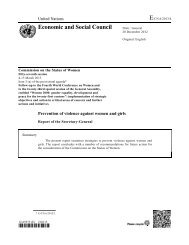
![IANSA [PDF, 2MB] - PeaceWomen](https://img.yumpu.com/25206379/1/190x123/iansa-pdf-2mb-peacewomen.jpg?quality=85)
![Commitments Sample [PDF, 93KB] - PeaceWomen](https://img.yumpu.com/25206331/1/190x245/commitments-sample-pdf-93kb-peacewomen.jpg?quality=85)


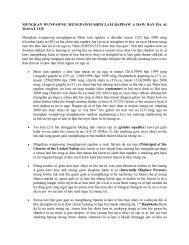
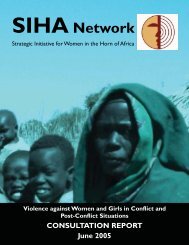



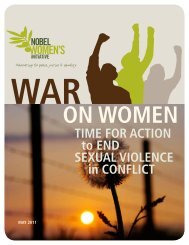
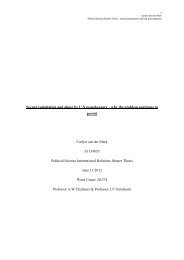

![A Toolkit for Advocacy and Action [PDF, 260KB] - Peace Women](https://img.yumpu.com/25205989/1/190x245/a-toolkit-for-advocacy-and-action-pdf-260kb-peace-women.jpg?quality=85)